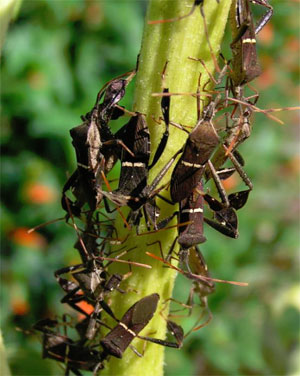Weekend Gardening: Catering To Stink Bugs
April 9, 2011
 There are some insect pests that simply laugh at insecticides. One such group is the stink bug family. Stink bugs are naturally tolerant of many pesticides; therefore, few insecticides are available to manage these damaging pests.
There are some insect pests that simply laugh at insecticides. One such group is the stink bug family. Stink bugs are naturally tolerant of many pesticides; therefore, few insecticides are available to manage these damaging pests.
Several different species of stink bugs occur in Florida including the brown stink bug, the green stink bug, the Southern green stink bug and the omnipresent leaffooted bug. This group alone damages 21 important commodities in the U.S. They are major pests of beans, peas, okra, soybean, cotton, peach, pecan, and tomato.
Stink bugs live through the winter as adults huddled in grass clumps, leaf litter and under tree bark. Adults emerge in the spring just as crops are starting.
Members of the stink bug family have piercing mouthparts. They insert their mouthparts into the plant tissue and ‘suck’ liquids from the plants. Damaged foliage often will turn yellow and eventually brown in color or become malformed in shape.
Curled, distorted okra pods are often the result of stink bug feeding. Tomatoes develop white or yellow, corky spots underneath the skin as a result of stink bug feeding and this damage imparts an off flavor to the fruit. Depending on the size of the seed when attacked, feeding on pea and bean seed may result in complete shriveling of the seed or cause sunken, ‘stung’ spots on the seed. This latter type of damage is often confused with that caused by cowpea curculio. Okra is seldom damaged extensively, but heavy infestations of stink bugs can cause serious damage to tomatoes, beans, and peas. Stink bugs also feed on corn, and can cause death of seedling plants or curled, ‘cowhorned’ ears.
One non-traditional way of dealing with these pests is through the use of “trap crops”. Trap crops are composed of one or more plant species that are grown to attract insects in order to protect the desired crop from the pest. Protection may be achieved either by preventing the pest from reaching the crop or by concentrating the pests in a certain part of the garden where they can be managed. The idea is to lure and cluster the pests by providing them a more desirable food source.
 Buckwheat, sunflower, millet and sorghum all serve as host plants for the four major stink bug and leaffooted bugs. Stink bugs are apparently very finicky with respect to plant growth stages and the quality of their food. Therefore, it is better to plant multiple trap crop species in order to maintain a continuously competitive food source to out compete your prized vegetable plants.
Buckwheat, sunflower, millet and sorghum all serve as host plants for the four major stink bug and leaffooted bugs. Stink bugs are apparently very finicky with respect to plant growth stages and the quality of their food. Therefore, it is better to plant multiple trap crop species in order to maintain a continuously competitive food source to out compete your prized vegetable plants.
There are a couple of methods of planting these trap crops. They can either be planted to encircle the crop or interspersed among the crop plants. Research has shown that stink bugs exhibit a pronounced ‚edge effect‛ while moving through your garden. They tend to congregate their populations in the border rows. Therefore, it is recommended that trap crops be placed between the suspected sources of stink bugs and the planted vegetables to intercept moving stink bugs. With smaller plots, it is probably better to plant the trap crop around the entire garden.
Just remember, once the trap crop attracts the pest stink bugs, it’s best to eliminate them by hand removal or other methods.
Theresa Friday is the Residential Horticulture Extension Agent for Santa Rosa County. Photos by Theresa Friday.
Comments
5 Responses to “Weekend Gardening: Catering To Stink Bugs”




I had tons of stink bugs last year. I heard since that one can use a hand vac and suck them up. I’m going to try that this year.
Prefer not to use pesticides…I know that some are good against these nasty bugs, but I’d rather harvest good ol’ homegrowns without the chemicals.
I started covering the fruits so that they aren’t as tempting with this white cloth material – seems to work well on squash and tomatoes, hard to manage with beans. I’ll be trying the buckwheat, as I hear it’s a great green manure once it’s tilled under. Aready have the sunflowers in another area that are drawing the bug away a bit.
Good article! Thanks, William!
If u have a restricted use pesticide license buy some penn cap m……kills em dead on contact….forget that organic junk
Ivory dish soap in water is what I spray.
added some cheap perfume , Imagine it smells bad to a stink bug .
Head Scratch
These bugs are great for spreading plant disease around too, even if they don’t prefer the garden plants they sample, they still ruin some that they “sample”, and the little ones they produce are voracious on vine plants like pole beans. The adults like to stab into the ripe tomatoes so when they are really bad I pick ‘em green.
I try to use soapy water in a spray bottle to keep them off some of my plants. It works when you spray the bugs directly, but doesn’t give lasting protection.